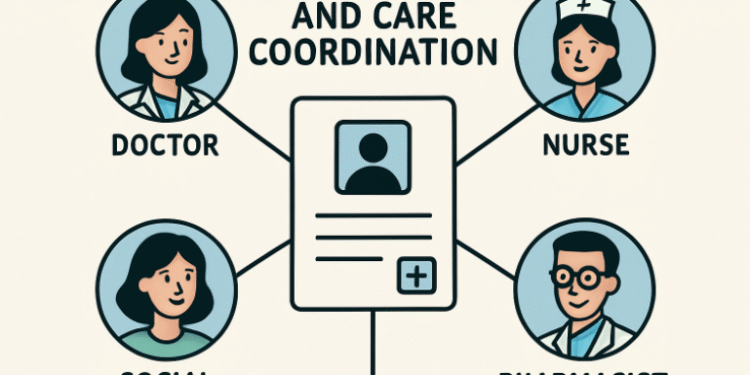In today’s fragmented healthcare landscape, care coordination pathways are vital for efficiently managing a patient’s journey across multiple touchpoints. These pathways involve intentional collaboration among healthcare providers, the patient, and often their family, to ensure that care is comprehensive, continuous, and tailored to individual needs. Through streamlined workflows and shared responsibilities, care coordination services help connect the dots that otherwise might be missed, leading to better overall health outcomes.
Care coordination pathways are increasingly recognized for their ability to smooth transitions between settings—such as from hospital to home care—while keeping all stakeholders informed and aligned. This collaborative effort is critical, particularly for patients managing complex or chronic conditions, who often interact with multiple healthcare professionals across different organizations.
Addressing Common Challenges in Patient Care
Despite medical advancements, patients can experience breakdowns in care due to miscommunication, incomplete records, or gaps in knowledge between providers. These disconnects often contribute to unnecessary hospital readmissions, medication errors, and a general lack of continuity in care. Care coordination addresses these frequent pitfalls by establishing clear roles, regular communication, and standardized protocols, resulting in smoother transitions and a greater patient safety net.
Improving coordination also supports families and caregivers, who may otherwise be left to independently navigate a confusing healthcare system. With designated points of contact and coordinated action plans, patients and their support networks gain confidence, reducing anxiety and improving engagement in the treatment process.
Building Multidisciplinary Teams for Improved Care
The most effective care coordination pathways bring physicians, nurses, pharmacists, social workers, and other specialists into a multidisciplinary team. Each member contributes unique expertise, ensuring all facets of a patient’s needs are addressed. Collaborative team meetings, shared access to records, and collective decision-making enable the team to craft patient-centered plans beyond medical treatment, including support for social, behavioral, and emotional health.
Regular interdisciplinary communication is key—ensuring that no detail is overlooked and that interventions are adaptive as patients’ conditions evolve. According to research from Health Affairs, multidisciplinary models are linked to substantial reductions in adverse events and improvements in chronic disease management.
Key Steps in Effective Care Coordination
Developing a practical care coordination pathway involves several straightforward but powerful steps:
- Assessment: Understanding the patient’s clinical, social, and environmental needs.
- Planning: Creating a comprehensive, individualized care plan that outlines interventions, medications, appointments, and goals.
- Management: Carrying out the plan, communicating changes, and ensuring the proper care is delivered at the right time.
- Follow-Up: Checking in regularly to monitor outcomes and adjust plans as necessary.
These structured phases ensure care is anticipatory rather than reactive, enabling earlier intervention and better outcomes.
Technology’s Role in Transforming Pathways
Adopting technology—particularly electronic health records (EHRs) and secure digital communication tools—has revolutionized care coordination. EHRs empower all care team members to securely access up-to-date patient data, minimizing errors and reducing redundancy in testing or treatments. Digital communication, such as telemedicine and care portals, makes it easier for patients to reach their providers, ask questions, and stay engaged in their care journey.
According to the Centers for Disease Control and Prevention (CDC), EHRs improve care quality and patient outcomes, making them essential to modern coordinated care pathways.
Evidence Behind Improved Outcomes
Studies reveal that coordinated care reduces preventable readmissions and medical errors. The Agency for Healthcare Research and Quality (AHRQ) highlights that team-based, coordinated interventions generally lead to better control of chronic conditions like diabetes and heart failure, improved medication adherence, and higher patient satisfaction. For example, some healthcare systems have reported a 30% reduction in hospital readmission rates after implementing robust care coordination pathways.
These measurable benefits underscore the value of structuring patient journeys around teamwork and information sharing instead of isolated care delivery.
Patient Involvement and Education
Patient engagement is essential for the success of any care coordination effort. When individuals understand their diagnoses, treatment options, and follow-up schedules, they are more likely to adhere to care plans and proactively communicate their needs or concerns. Educating patients and families fosters active participation, shared decision-making, and greater trust in the healthcare team. According to the National Institutes of Health, patient education is critical in effective chronic disease management, leading to improved health behaviors and outcomes.
Real-Life Examples: How Coordination Changes Lives
Consider an elderly patient with congestive heart failure, diabetes, and limited mobility. Without coordinated care, she might experience overlapping medications, missed follow-up appointments, or conflicting dietary advice. After enrolling in a comprehensive care coordination program, this patient gained an assigned care coordinator, regular visits from a nurse, medication management support from a pharmacist, and access to telehealth sessions. Within months, her hospitalization rates dropped, and she reported feeling more empowered and informed about her care.
Another scenario is a post-surgical patient who benefits from timely handoffs between the hospital team and home health services, with a shared digital record ensuring that all parties—family caregivers included—are up to date on discharge instructions, wound care, and rehabilitation schedules. These successes illustrate the profound day-to-day impact of coordinated, patient-centered care.
Looking Forward: Scaling Successful Approaches
Successfully scaling care coordination pathways requires continuous staff training, investment in interoperable technology, and the establishment of best practices that can be adapted to diverse populations. Health systems can benefit from fostering partnerships with community organizations, leveraging data to identify at-risk patients early, and creating feedback loops that drive ongoing improvement.
Overcoming barriers—such as inconsistent funding, resistance to workflow changes, or health disparities in IT access—calls for strong leadership and clear communication of the tangible benefits. As more payers and policymakers recognize the value of coordinated care, broader adoption of these pathways will be instrumental in advancing health equity and delivering lasting improvements in patient outcomes.










